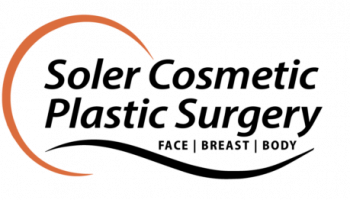At Soler Cosmetic Plastic Surgery in Tampa, FL, we are proud to offer rhinoplasty, one of the most popular cosmetic procedures in the world. Known colloquially as a nose job, this procedure is designed to improve the aesthetic of the nose by correcting asymmetry or changing the size of the nose. It can also be used to make someone look several years younger by removing excess skin and tightening sagging skin.
To help you determine whether this procedure is appropriate for you, we are discussing how long the post-operative recovery process takes and what you can do to make it as quick and comfortable as possible. Here’s what you need to know about the entire recovery process.
How Long Is Recovery After Rhinoplasty?
After rhinoplasty, there is only a week or two of downtime. However, the entire recovery process can take up to 13 months. It is not uncommon for recovery to take over a year if the cartilage of the nose is manipulated significantly.
Is There Anything I Can Do To Shorten the Recovery Process?
Yes, you can take steps to ensure you heal as quickly as possible after your rhinoplasty. For example, you can get plenty of sleep, drink lots of water, and eat enough protein. Here’s a closer look at the post-op care steps you can take for the smoothest recovery possible.
Eat Protein With Every Meal
If you want your recovery process to be complete as quickly as possible, make a point to eat protein with every meal. It is advisable to get a total of 50 to 60 grams of protein every day, depending on your weight. If you find yourself without much of an appetite, make sure you get enough protein by drinking a protein shake or two. For a healthier option, you can make a smoothie with a Greek yogurt or Icelandic yogurt base. Traditional yogurt is lower in protein.
You can pack even more protein into your smoothie by adding a dark, leafy vegetable, like spinach or kale. Throw in a few of your favorite frozen fruits, and you don’t even have to add ice to your smoothie. You’ll get just as much nutritional value as you would if you used fresh fruit. Spinach and kale are great vegetables to add to your smoothies because they are high in soluble fiber, vitamin C, and water in addition to protein.
Eat Fruits and Vegetables
Even if you don’t want to incorporate smoothies into your post-op diet, it is still important that you incorporate fruits and veggies into your post-op diet. To help you get your recommended daily allowance of all your essential micronutrients, you should eat at least one serving of fruit and one serving of vegetables with every meal. If you feel a little peckish between meals, you may want to snack on fruits, vegetables, or nutrient-dense nuts.
Drink Water Regularly
Hydration is another crucial component of your recovery process. It is very important to eat and drink plenty of protein and vitamin C because they contain the building blocks necessary to produce collagen. However, your skin can’t produce collagen efficiently if you’re dehydrated. Also, dehydration negatively affects your circulation, and your circulatory system plays a major role in your recovery.
For the fastest recovery possible, you need to ensure you have pale urine. If it is dark, you need to drink more hydrating fluids or eat more foods with a high water content. If you have clear urine, you may be suffering from water intoxication. Take a break from drinking and eat something high in potassium to flush out the extra water. Generally, you should aim to drink around half a gallon of water daily.
Commit Plenty of Time to Sleep
You can also speed up your recovery process by making plenty of time to sleep. Most of your body’s healing occurs during the rapid eye movement phase of sleep. This phase occurs at the end of the sleep cycle. Usually, you only need around seven hours of sleep for optimal health, but you should do your best to get nine consecutive hours of sleep every night during the first couple of weeks following your nose job.
If you have trouble falling asleep or staying asleep, you may benefit from avoiding blue light from monitors for two to three hours before bed. This pre-bedtime block of time is perfect for taking a relaxing bath, cuddling with your puppy, or working on a word or number puzzle book. If you wake up in the middle of the night to use the restroom, you may want to increase your sodium intake a little or stop drinking several hours before bed.
Minimize the Amount of Pressure Applied to Your Nose
You can also ensure your recovery period doesn’t last longer than it has to by minimizing the amount of pressure applied to your nose. Specifically, you should sleep on your back rather than your side or stomach. If you tend to toss and turn in your sleep, consider sleeping in a recliner or sleeping with pillows or rolled-up towels against your sides. It is also important to note that your head should be elevated by at least two pillows when you sleep.
If you wear glasses, you should strongly consider not wearing them for one to six weeks after your procedure. The less pressure applied to your nose regularly, the faster your nose will heal. If you can’t go without wearing your glasses, only wear them when absolutely necessary.
Refrain From Taking Hot Showers
Excessive heat should also be avoided during the first couple of weeks of your recovery. Instead of taking steaming hot showers, take tepid baths. Just be careful to keep your splint dry. During your initial consultation, we will give you specific instructions on how to care for your nose throughout the recovery process.
Refrain From Vigorous Exercise
Vigorous exercise is great for your cardiovascular and pulmonary health most of the time. However, it will slow down your recovery process significantly by taking away too much energy from healing and elevating your blood pressure. That said, moderate exercise is great for speeding up your recovery process. Ideally, you should get at least 30 minutes of moderate exercise every day during your recovery that you feel up to it.
During the first few days of your recovery period, you may want to walk around your house or yard so it is easy for you to sit down and take a break when you need to rest. However, you can start walking around your neighborhood or a nearby park once you feel confident that you can walk for 30 minutes without needing to rest.
Refrain From Blowing Your Nose
You cannot blow your nose for the first seven days following your nose job. However, it is ideal to go three weeks without blowing your nose. If, during this time, you find that your nose is itchy, alleviate the itchiness with a saline-based nasal spray.
Have Someone Help You Around the House
You can also speed up your recovery process by having someone help you around the house. You can’t lift anything over 10 pounds during the first couple of weeks after your nose job, so it is a good idea to have someone to help you take care of any children or pets you may have.
Even if you don’t have any dependents living with you, it is essential that you have someone drive you home after your procedure. You can’t drive within 24 hours of receiving anesthesia.
Schedule Your Initial Consultation To Learn More
Rhinoplasty can change the size or shape of your nose to improve your self-confidence. If you think you could benefit from this procedure, you should keep in mind that the entire recovery process can take up to 13 months, but you will only need to take a week or two off from work and you can resume all normal activities in just four to six weeks.
For more information on this procedure or the recovery process, contact us today at Soler Cosmetic Plastic Surgery in Tampa, FL to schedule your initial consultation. We can’t wait to meet you and tailor a treatment plan that addresses all of your cosmetic goals. Whether you were born with asymmetry, a hump, or a bulbous tip or an injury has changed the shape or functionality of your nose, Dr. Soler can’t wait to help you.





